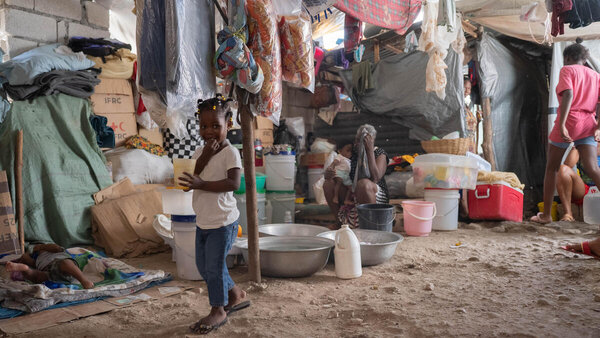WFP warns Haiti's most vulnerable hit hard by deepening crisis

PORT-AU-PRINCE, Haiti – Women, children and displaced families are hardest hit by Haiti’s prolonged crisis, which is driving rising hunger and vulnerability to malnutrition, the UN World Food Programme (WFP) warned today. The alert follows the release of the latest Integrated Food Security Phase Classification (IPC) analysis.
A record 5.7 million people—51 percent of the total population—are currently experiencing acute levels of hunger, a three percent increase from last year, according to the IPC. More than 1.2 million children under-5 are living in areas affected by high levels of food insecurity, putting them at heightened risk of malnutrition.
“WFP has ramped up its response to reach a record 2.2 million Haitians this year,” said WFP Haiti Country Director Wanja Kaaria. “However, needs continue to outpace resources. If this continues, families will potentially fall further into hunger, and we simply don’t have the resources to meet all the growing needs.”
Armed violence, economic decline, persistent inflation and poor agricultural output continue to drive Haiti’s worsening crisis. If current trends persist, more than 5.9 million people could face acute food insecurity or worse by March 2026, according to the latest analysis. In the North-West and West departments, including Port-au-Prince, malnutrition rates have reached Critical (Phase 4) levels or higher.
An estimated 1.3 million Haitians displaced by armed violence are among the most food insecure. Three in four people sheltering in schools and public buildings face Crisis (IPC 3) or Emergency (IPC 4) levels of hunger. Overcrowded and unsanitary conditions, coupled with limited access to nutritious food, are putting babies and young children at heightened risk of malnutrition.
The IPC analysis does show the effectiveness of collective humanitarian efforts to prevent famine. Intensified food assistance has lifted about 8,400 displaced people from Catastrophic (IPC 5) to Emergency (IPC 4) levels of hunger. Overall, regular food assistance has reduced the number of Haitians facing Emergency-level food insecurity (IPC 4) by approximately 200,000 since April 2025.
“These small but significant gains show that when WFP has the resources and works in close collaboration with governments and partners, we can turn the tide of hunger. With sustained and predictable support, we can keep driving down food insecurity, while also investing in lasting solutions that tackle the root causes of hunger,” added Kaaria.
The crisis in Haiti is acutely underfunded. WFP requires US$139 million for next 12 months to reach the country’s most vulnerable families.
# # #
Note to editors:
Broadcast quality footage can be accessed here.
Photos can be accessed here.
WFP has produced a series of reports to examine the food security implications of the funding crisis, titled A Lifeline at Risk: food assistance at a breaking point. The Haiti-focused report can be accessed here.
Haiti emergency page here.
The United Nations World Food Programme is the world’s largest humanitarian organization saving lives in emergencies and using food assistance to build a pathway to peace, stability and prosperity for people recovering from conflict, disasters and the impact of climate change.
Follow us on X, formerly Twitter, via @WFP_Haiti
A previous version of this media release included data from a Government report on malnutrition rates.
Topics
Food security Emergencies NutritionContact
For more information please contact (email address: firstname.lastname@wfp.org):
Tanya Birkbeck, WFP/Port-au-Prince, Mob. +509 3735 4333
Maria Gallar Sanchez, WFP/Panama City, Mob. +34 662 435 125
Gemma Snowdon, WFP/ Rome, Mob. +39 347 382 3210
Nina Valente, WFP/ London, Mob. +44 (0)796 8008 474
Martin Rentsch, WFP/Berlin, Mob +49 160 99 26 17 30
Shaza Moghraby, WFP/New York, Mob. + 1 929 289 9867
Rene McGuffin, WFP/ Washington Mob. +1 771 245 4268
